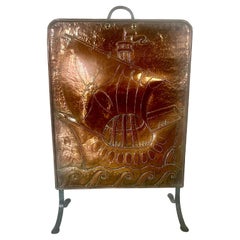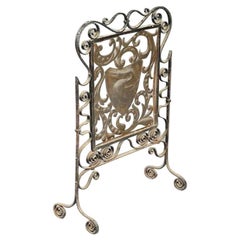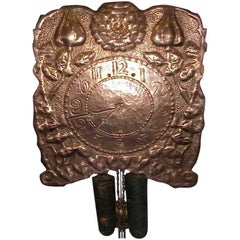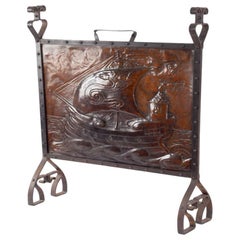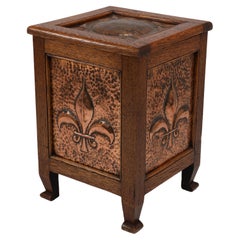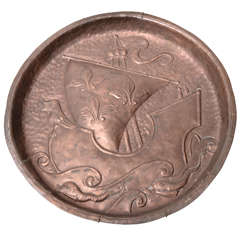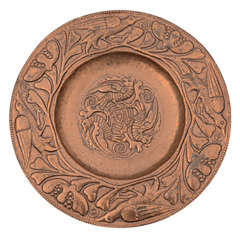John Pearson Copper
Early 20th Century English Arts and Crafts Screens and Room Dividers
Copper
Early 20th Century Great Britain (UK) Arts and Crafts Fireplace Tools an...
Copper, Iron
Antique Early 1900s British Arts and Crafts Wall Clocks
Copper
Antique Early 1900s English Arts and Crafts Fireplace Tools and Chimney ...
Copper, Wrought Iron
Antique Early 1900s English Arts and Crafts Fireplace Tools and Chimney ...
Copper
Recent Sales
Early 20th Century British Arts and Crafts Decorative Art
Copper
Early 20th Century English Arts and Crafts Decorative Art
Copper
Early 20th Century English Fireplace Tools and Chimney Pots
Copper, Iron
Antique Late 19th Century English Arts and Crafts More Dining and Entert...
Copper
Early 20th Century British Arts and Crafts Platters and Serveware
Early 20th Century Arts and Crafts Decorative Boxes
Copper
Antique 19th Century English Wall Mirrors
Copper
20th Century Arts and Crafts Serving Pieces
Copper
Early 20th Century Arts and Crafts Wall Mirrors
Copper
Antique 19th Century British Arts and Crafts Boxes
Antique Early 1900s English Arts and Crafts Serving Pieces
Copper
People Also Browsed
Early 20th Century English Arts and Crafts Fireplace Tools and Chimney Pots
Copper, Iron
Antique Mid-19th Century English High Victorian Taxidermy
Other
Early 20th Century German Arts and Crafts Shelves
Wrought Iron
Early 20th Century European Arts and Crafts Table Lamps
Brass, Copper
21st Century and Contemporary American Fireplace Tools and Chimney Pots
Iron
Antique 1750s French Architectural Elements
Oak
Antique Late 19th Century European Moorish Architectural Elements
Wrought Iron
Early 20th Century European Arts and Crafts Fireplace Tools and Chimney ...
Wrought Iron
Antique 1890s English Arts and Crafts Card Tables and Tea Tables
Oak
Antique 1890s Great Britain (UK) Arts and Crafts Fireplace Tools and Chi...
Walnut
Vintage 1920s European Art Nouveau Cabinets
Wood
Antique Late 19th Century Arts and Crafts Fireplace Tools and Chimney Pots
Copper
Antique Early 1900s Neoclassical Revival Fireplace Tools and Chimney Pots
Iron
Vintage 1910s American Art Nouveau Table Lamps
Bronze
Vintage 1910s American Art Nouveau Table Lamps
Bronze
Antique 1880s Arts and Crafts Fireplace Tools and Chimney Pots
Copper
John Pearson Copper For Sale on 1stDibs
How Much is a John Pearson Copper?
A Close Look at Arts And Crafts Furniture
Emerging in reaction to industrialization and mass production, the Arts and Crafts movement celebrated handcrafted design as a part of daily life. The history of Arts and Crafts furniture has roots in 1860s England with an emphasis on natural motifs and simple flourishes like mosaics and carvings. This work is characterized by plain construction that showcases the hand of the artisan.
The earliest American Arts and Crafts furniture dates back to the start of the 20th century. Designers working in this style in the United States initially looked to ideas put forth by The Craftsman, a magazine published by Wisconsin native Gustav Stickley, a furniture maker and founder of the Craftsman style. Stickley’s furniture was practical and largely free of ornament. His Craftsman style drew on French Art Nouveau as well as the work he encountered on his travels in England. There, the leading designers of the Arts and Crafts movement included William Morris, who revived historical techniques such as embroidery and printed fabrics in his furnishings, and Charles Voysey, whose minimal approach was in contrast to the ornamentation favored in the Victorian era.
American Arts and Crafts work would come to involve a range of influences unified by an elevation of traditional craftsmanship. The furniture was often built from sturdy woods like oak and mahogany while featuring details such as inlaid metal, tooled leather and ceramic tiles. The style in the United States was led by Stickley, whose clean-lined chairs and benches showcased the grain of the wood, and furniture maker Charles Rohlfs, who was informed by international influences like East Asian and French Art Nouveau design.
Hubs in America included several utopian communities such as Rose Valley in Pennsylvania and the Byrdcliffe Arts and Crafts Colony in New York, where craftspeople made furniture that prioritized function over any decoration. Their work would influence designers and architects including Frank Lloyd Wright, who built some of the most elegant and iconic structures in the United States and likewise embraced a thoughtful use of materials in his furniture.
Find antique Arts and Crafts chairs, tables, cabinets and other authentic period furniture on 1stDibs.
Materials: Copper Furniture
From cupolas to cookware and fine art to filaments, copper metal has been used in so many ways since prehistoric times. Today, antique, new and vintage copper coffee tables, mirrors, lamps and other furniture and decor can bring a warm metallic flourish to interiors of any kind.
In years spanning 8,700 BC (the time of the first-known copper pendant) until roughly 3,700 BC, it may have been the only metal people knew how to manipulate.
Valuable deposits of copper were first extracted on the Mediterranean island of Cyprus around 4,000 BC — well before Europe’s actual Bronze Age (copper + tin = bronze). Tiny Cyprus is even credited with supplying all of Egypt and the Near East with copper for the production of sophisticated currency, weaponry, jewelry and decorative items.
In the 15th, 16th and 17th centuries, master painters such as Leonardo da Vinci, El Greco, Rembrandt and Jan Brueghel created fine works on copper. (Back then, copper-based pigments, too, were all the rage.) By the late 19th and early 20th centuries, decorative items like bas-relief plaques, trays and jewelry produced during the Art Deco, Arts and Crafts and Art Nouveau periods espoused copper. These became highly valuable and collectible pieces and remain so today.
Copper’s beauty, malleability, conductivity and versatility make it perhaps the most coveted nonprecious metal in existence. In interiors, polished copper begets an understated luxuriousness, and its reflectivity casts bright, golden and earthy warmth seldom realized in brass or bronze. (Just ask Tom Dixon.)
Outdoors, its most celebrated attribute — the verdigris patina it slowly develops from exposure to oxygen and other elements — isn’t the only hue it takes. Architects often refer to shades of copper as russet, ebony, plum and even chocolate brown. And Frank Lloyd Wright, Renzo Piano and Michael Graves have each used copper in their building projects.
Find antique, new and vintage copper furniture and decorative objects on 1stDibs.
